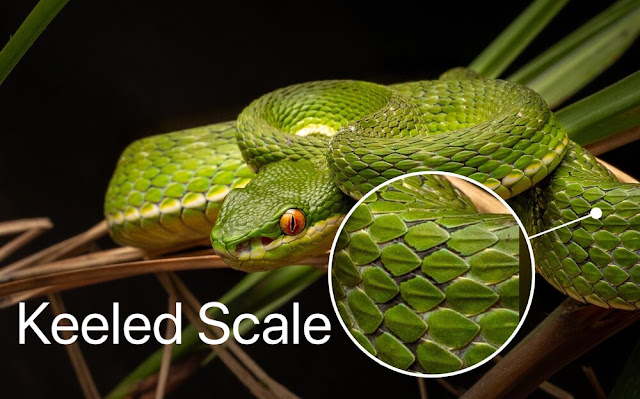Pit Vipers-- Rattlesnake
Pit Vipers have one of the most advanced venom injection systems in the world. Their bites are breathtakingly fast and if you are bitten by one you may only have hours to react. However, since their venom takes longer to affect their prey than other snakes, they will follow their prey while they die. This is called prey re-localization. Pit vipers track their dying prey by following the scent of their venom though that scent will also attack competing pit vipers to the kill. Vipers are ambush hunters and spend most of their lives hiding and wait for prey. Many species of Pit Vipers are arboreal and hide up in the trees. Once the target is in range, they can strike in a quarter of a second. When hunting or defending, Pit Vipers are incredibly dangerous most of the time. Viper's are very easy to tell apart from other snakes because of their scales. Most snakes are smooth but Vipers have keeled scales which means that they overlap with a leading edge giving them their distinct and bumpy appearance.
Keeled scales are less reflective than flat scales and allow them to blend in better to their environments but none are more amazing looking than the bush Viper. Endemic to sub-saharan Africa bush Vipers have highly keeled scales giving them that very sharp beautiful and artistic appearance. The species is chromosomally polymorphic meaning they come in a lot of different colors but green is the most common. Vipers are amazingly beautiful coloration which is used to warn potential predators of their deadly venom. All of the Vipers found in the Americas are pit vipers deriving their name from the heat-sensing or again they have between their eyes which sort of gives them night vision. When infrared radiation enters the organ via small holes in their faces the Pit Vipers can detect the difference in temperature between moving prey and its surroundings. The Sixth Sense generates somewhat of a thermal image which allows them to detect the warm bodies of prey at night and up to a meter away even when deprived of all of their other senses. Pit vipers have been proven able to find prey that is just point 2 degrees warmer than its surroundings.
One of the coolest types of pit viper is the rattlesnake these are only found in North America and are Canada's only venomous snakes.
They get their name from a rattle at the base of their tail that they use to warn predators to back off or suffer the consequences. Their rattle is made of modified scales that have become hollow interlocked segments. They will shake the rattled 50 times a second and can sustain shaking for up to 3 hours. When they are born, the babies can't rattle and it takes two sheds to develop the hardened tip required for rattling.
Of the ten most venomous snakes North America, nine of Vipers and seven of which are rattlesnakes, the other two are the cottonmouth and the copper head. Vipers get their name from the Latin Vee para which means live birth this is because vipers give birth to live babies not eggs which is uncommon amongst other snakes. Interestingly enough species that live in colder climates will brew mate the reptilian equivalent of hibernating often they will brew mate in large groups of up to a thousand strong and what's called a viper den.


Comments
Post a Comment